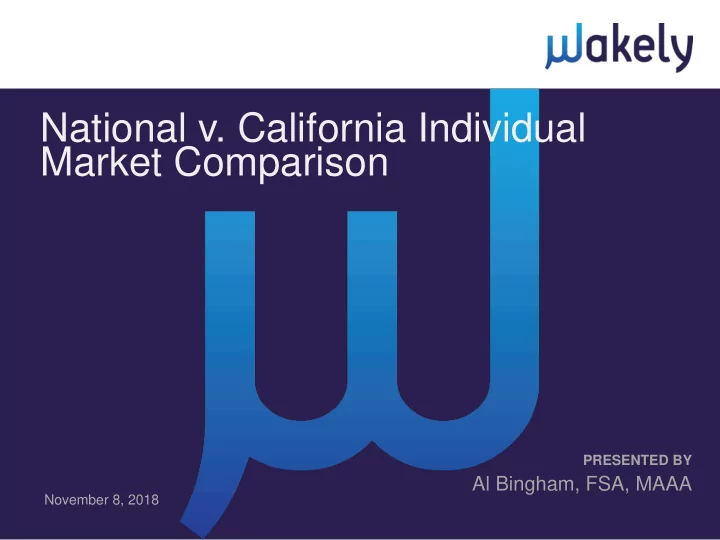

National v. California Individual Market Comparison True BUSINESS PowerPoint Presentation Template PRESENTED BY Al Bingham, FSA, MAAA November 8, 2018 Page 1
Agenda Genesis of the Project Research Question and Goals Data and Methodology Evidence of California’s Success Limitations and Next Steps Page 2
Genesis of the Project Covered California vision and market success John Bertko connection Data and outstanding analysis Unique and available Wakely National Risk Adjustment Reporting data Page 3
Research Question What is the source of California’s Individual Market success? Description of California’s Market Largest individual market and one of the largest relative to eligible population 1.4 million Covered CA enrollees 700,000 “Off-Exchange” enrollees outside of Covered CA Among lowest risk scores (best health) in the U.S. by state Lower premium growth Robust issuer participation Page 4
Data and Methodology Data Source Wakely’s National Risk Adjustment Reporting Program (WNRAR) simulates the federal results more quickly for insurer actuaries to use Collects diagnostic and demographic data (but not cost) Over 85 participating health insurance carriers in over 30 states since 2014 Risk Scores measure average actuarial risk for both on- and off- Exchange enrollees To best measure health differences between California and other states Wakely adjusted risk scores for certain non-health related factors Data used was generally from 2015-2017 Same Risk Adjustment coefficients for 2017 used for all three years. Page 5
Various Attributes Studied Risk Score comparison by Metal Tier Enrollees choose one of four levels of coverage (Bronze, Silver, Gold, Platinum) Bronze enrollees are generally healthier and use fewer services Enrollees can be either on the Exchanges or off the Exchanges On-Exchange enrollees are eligible for premium subsidies and are generally lower income Off-Exchange enrollees tend to have earnings above the top subsidy point of about $48,000 per person States made differing policy choices Most (~30) expanded Medicaid coverage, which enrolled higher risk enrollees to this program for low-income people Many allowed “transition policies” to remain – kept previously underwritten (healthy) enrollees outside the Single Risk Pool A few states (~15) established and managed their own Exchanges (called SBEs); the others (called FFEs) used the default federal Exchange Page 6
Comparison-California versus Other States California Really is Different HCC = Hierarchical Condition Categories Enrollment in Member-Months Silver Tier Risk Scores Healthy Enrollees: Zero HCC Prevalence 2015 2016 2017 2015 2016 2017 2015 2016 2017 Year 24,360,426 25,401,504 24,587,903 1.141 1.164 1.216 81% 82% 81% California Other States in 84,234,644 92,091,462 82,528,173 1.342 1.403 1.477 79% 79% 78% Wakely study Page 7
Risk Score Comparison California’s success spans metal levels and years Enrollees can choose high cost-sharing (Bronze tier) or lower cost-sharing (Silver or Gold Tiers) Page 8
California’s Success not Limited to On- Exchange Members Enrollment Has Declined Substantially in Other States Page 9
Health as Key Driver Health, not Demographics (age), is what drives California’s lower risk scores Page 10
Potential Explanations Policy Choices Medicaid Expansion SBEs Transitional Plans Outreach Efforts Covered CA spends as much in 2016 as the whole federal market Page 11
Caveats and Next Steps The data cover only 33 states and approximately 50% of member months for each of the respective years. While we believe the data is representative, further analysis would be needed and it is possible some of the missing data would influence the results. The EDGE data used for this analysis is plan level data, and enrollee specific data is not identifiable. Another limitation may be that some state characteristics exogenous to the individual market, such as the prevalence of obesity in the state’s population, have an effect The individual market environment is rapidly changing (state markets are changing) “constantly” and the federal regulatory environment is in flux Study does have key caveats: https://www.healthaffairs.org/do/10.1377/hblog20180710.459445/full/ Page 12
Questions and Discussion Page 13
Recommend
More recommend